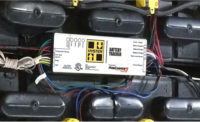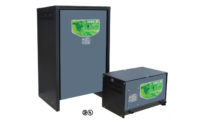Battery, forklift maintenance tips to achieve sustainable cold storage operations
In order to achieve continued uptime for forklift operations and shipment productivity in even the coldest conditions, it’s important to understand the chemistry behind the battery and the unique internal design features.

Cold storage facilities can be a battery’s worst enemy. From lost capacity to chronic undercharging, the cold hard fact is that using the wrong battery in a cold storage environment can have a chilling impact on your bottom line. In order to achieve continued uptime for forklift operations and shipment productivity in even the coldest conditions, it’s important to understand the chemistry behind the battery and the unique internal design features needed to stand up against this bitter cold threat.
Why temperature matters for battery function
The low temperatures needed to properly store frozen products such as produce and meats can have a detrimental effect on the power and performance of some batteries. Conventional lead acid batteries often have a fairly narrow temperature window and cannot function or offer long cycle life in cold storage applications. Depending on the internal temperature that a standard, lead acid battery reaches in a cold storage area, its energy density can significantly diminish. For example, with an internal temperature of 32°F, a fully charged conventional lead acid battery will only deliver 75% of the power it would at a normal room temperature of 77°F. With an internal temperature of 0°F, that same battery’s available energy would drop to 40%.
These types of energy density losses occur because exposure to cold temperatures increases the viscosity of a battery’s electrolyte. As the electrolyte fluid thickens, its diffusion through the pores of the active battery plate slows, making it harder to achieve the chemical reaction needed to power the application. As temperatures and power capacities drop, the corresponding dip in run times can be significant. For instance, a battery designed to operate for eight hours in ambient environments may only last 4-6 hours in cold storage facilities.
Battery charging complications
Cold-driven reductions in battery run times can make it very difficult for operators to maintain proper run and charge cycles. Adding to complexity of the operation, cold batteries can take longer to charge depending on the battery temperature and charger capability. Because cold applications are more commonly multi-shift operations, a single misstep in the battery charge cycle sends a cascading effect through the fleet. A poorly charged battery results in a premature swap, which eats time and leads to further battery abuse. A good first step is to ensure operators run batteries as long as they can, despite the desire to perform the inevitable mid-shift swap earlier than needed. Once the battery is depleted, operators should allow a full recharge before placing it back in the cold storage application. If you continue down a path of short-cycling batteries and not fully charging or equalizing weekly, conventional lead acid batteries quickly develop major issues due to electrolyte stratification and cell imbalances. The result is shorter and shorter run times as the battery ages.
Battery technology handles harsh cold conditions
Thanks to today’s innovative technologies, batteries for cold storage applications can be manufactured with special features to optimize the performance at low temperatures. When deciding on your cold storage power solution, look for a battery with an electrolyte mixture specially designed for cold environments, and ideally, one with corrosion-resistant plates that have a high lead content. This combination will slow down the detrimental effects that cold temperatures have on a battery.
Batteries featuring advanced Thin Plate Pure Lead (TPPL) technology are constructed with 99% pure lead. Classified as non-spillable electric storage batteries, TPPL batteries provide unmatched performance across a wide range of temperatures, including cold storage applications. Because the plates are thinner than those in conventional batteries, more of them can fit into the battery – more plates deliver more power in 30% less space than an equivalently sized flooded lead-antimony battery. Because there are more plates than a traditional lead-antimony battery, the increased viscosity of the electrolyte at low temperatures does not have as much of an effect on the performance. The increased plate surface maintains more energy, and more power during peak load periods.
Pure lead also self-discharges at a much slower rate than batteries containing lead plate additives, which means TPPL batteries can have a shelf life of up to two years before needing recharging. They have the highest recharge efficiency of any sealed lead acid battery on the market today; they can be fully recharged in 4-6 hours with no risk of damage from overheating. This ability to fast charge at such a high rate can eliminate battery change-outs for some multi-shift operations, slashing costs and maintenance dramatically.
Battery monitoring systems are also a critical component to ensure your battery performance and life in maximized in cold environments. In many older battery chargers, the battery temperature is set to a constant value to estimate the proper charging profile for the application. Without feedback from the battery, there is risk of undercharging batteries that are colder than expected, or severely overcharging batteries that are warmer than expected. This variation in battery temperature during charging can greatly shorten usable battery life. Highly advanced charger and battery monitoring systems can wirelessly communicate battery temperature during the charge, which allows the ideal recharge every time. Charge times are minimized, with no risk of overcharge if the battery warms during charge. These systems also measure a variety of performance factors, including a battery’s state of charge, temperature, voltage and current, and then provide real-time alerts and potential warnings while the battery is in use. This can be used to correct operator issues before repeated concerns cause challenges in productivity and irreversible battery damage.
Forklift cold storage considerations
Operating forklifts in cold storage facilities can be a daunting task that limits productivity if the vehicles are not properly maintained and stored in the right temperature-controlled environment. One of the main challenges facing cold room forklifts is the condensation that can form in warm temperatures, leading to your equipment unnecessarily freezing when re-entering frigid storage areas. An easy solution is to store forklifts in a dry area that’s only slightly above freezing temperature to ensure that condensation forms slowly or not at all.
However, this isn’t always possible, especially when there is very limited cold storage space in the warehouse. When that’s the case, provide enough time for the forklift to rest completely outside of the cold storage area in warm temperatures in order for any condensation that forms to evaporate before re-entering the warehouse. The evaporation process can be accelerated by the use of circulating fans positioned in front of the vehicle. Furthermore, optimizing the paths that cold room forklifts must take between the cold environment and the truck loading dock can help ensure that they stay in cold spaces as often as possible and keep running at peak performance.
In order to run your cold storage facilities and forklift equipment successfully in these types of cool temperature environments, choosing the right battery and implementing the right forklift maintenance strategies are vital to ensure continued reliability, productivity and profitability across your chilly operations.
Looking for a reprint of this article?
From high-res PDFs to custom plaques, order your copy today!





